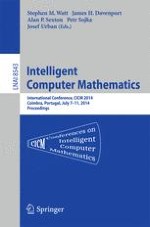This book constitutes the joint refereed proceedings of Calculemus 2014, Digital Mathematics Libraries, DML 2014, Mathematical Knowledge Management, MKM 2014 and Systems and Projects, S&P 2014, held in Coimbra, Portugal, during July 7-11, 2014 as four tracks of CICM 2014, the Conferences on Intelligent Computer Mathematics. The 26 full papers and 9 Systems and Projects descriptions presented together with 5 invited talks were carefully reviewed and selected from a total of 55 submissions. The Calculemus track of CICM examines the integration of symbolic computation and mechanized reasoning. The Digital Mathematics Libraries track - evolved from the DML workshop series - features math-aware technologies, standards, algorithms and processes towards the fulfillment of the dream of a global DML. The Mathematical Knowledge Management track of CICM is concerned with all aspects of managing mathematical knowledge in the informal, semi-formal and formal settings. The Systems and Projects track presents short descriptions of existing systems or on-going projects in the areas of all the other tracks of the conference.
